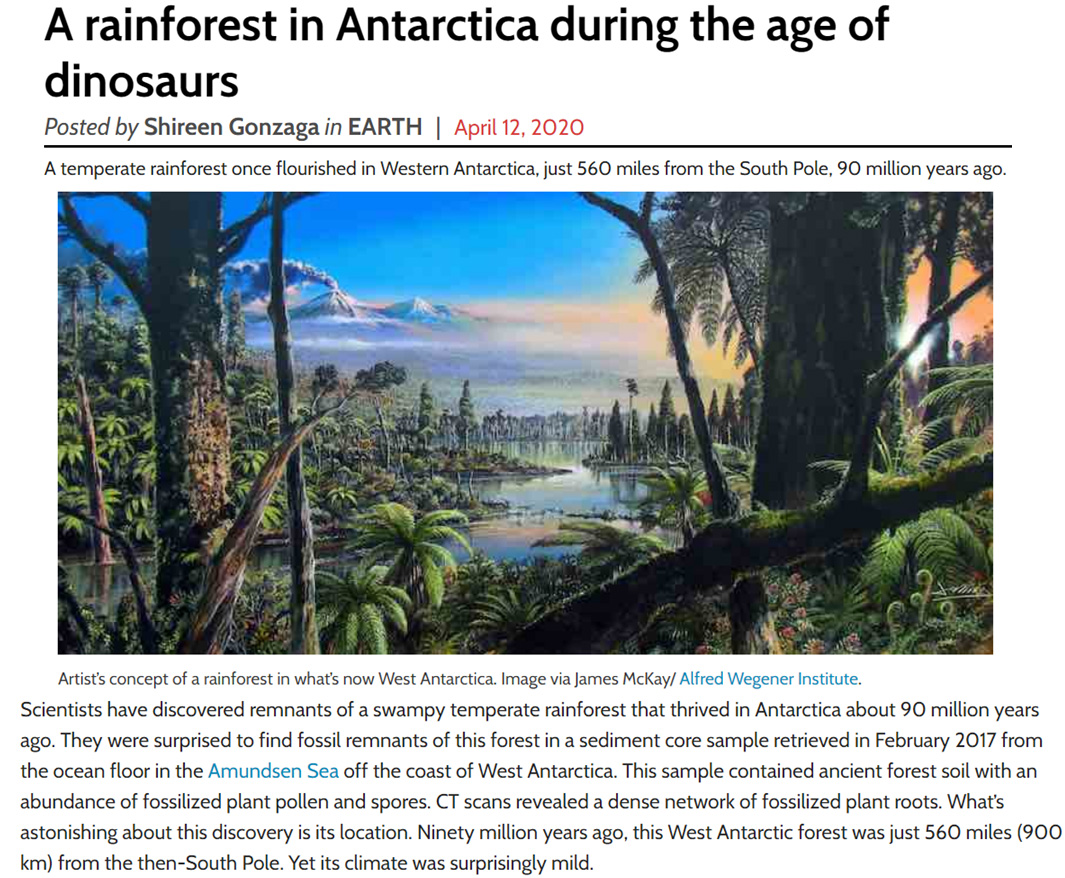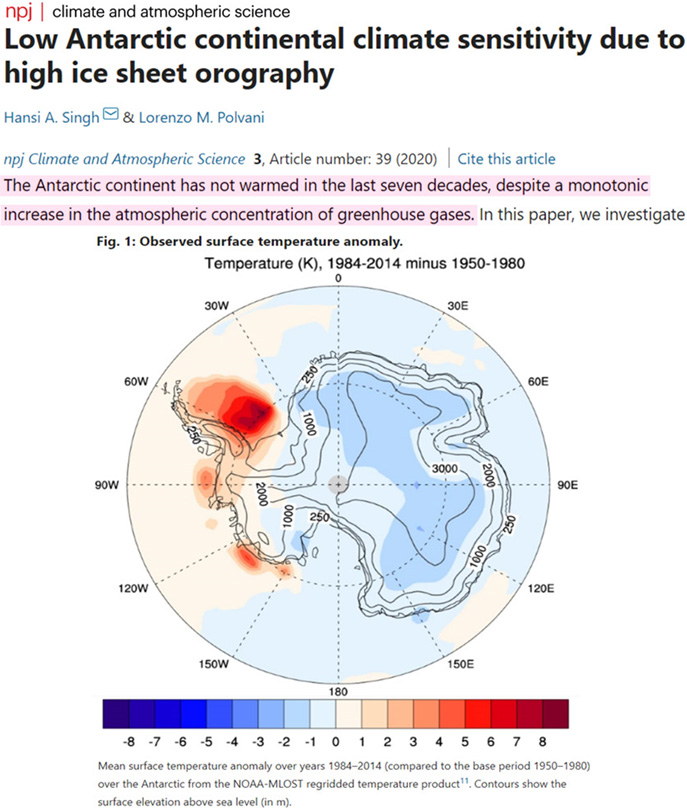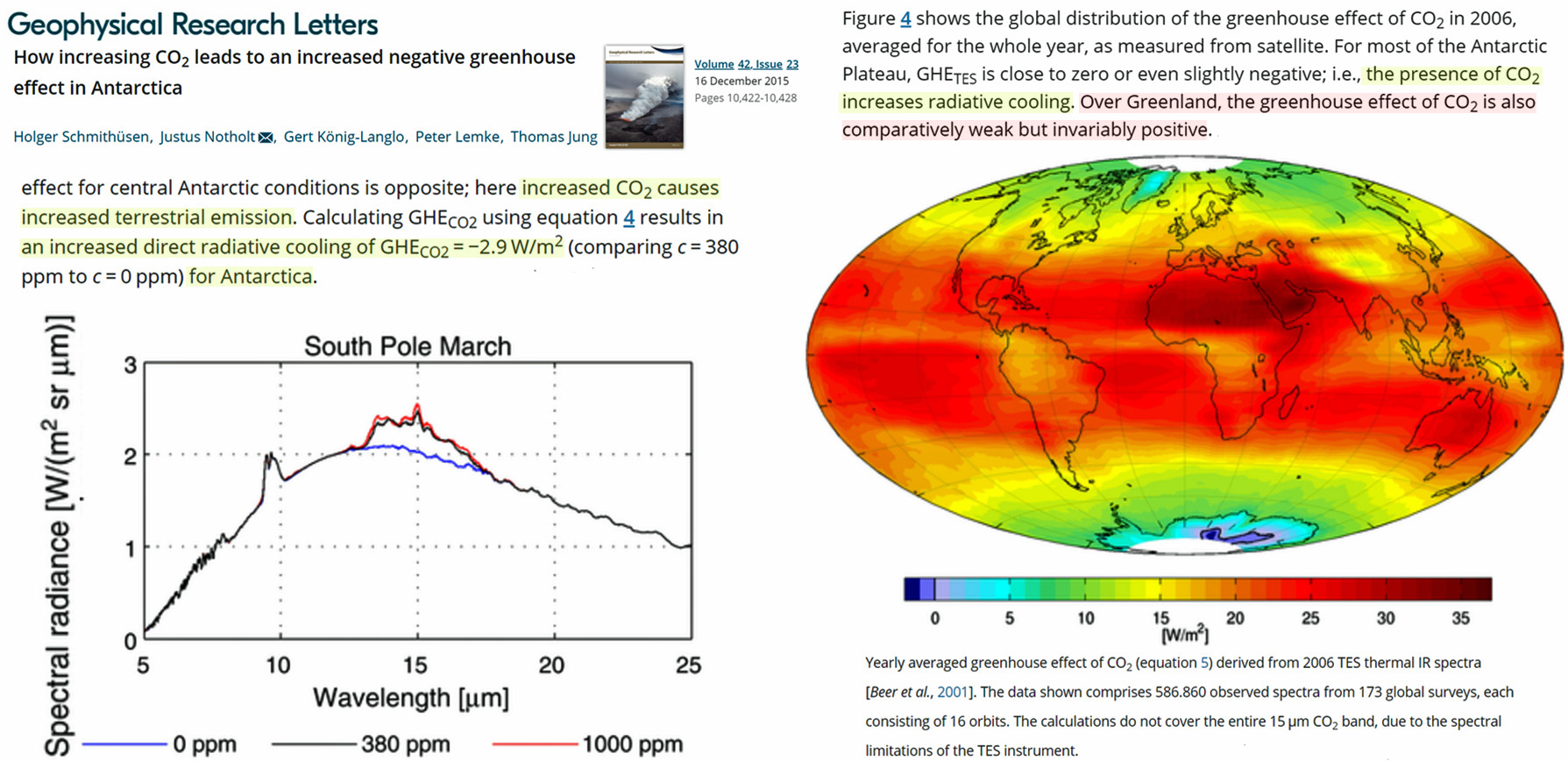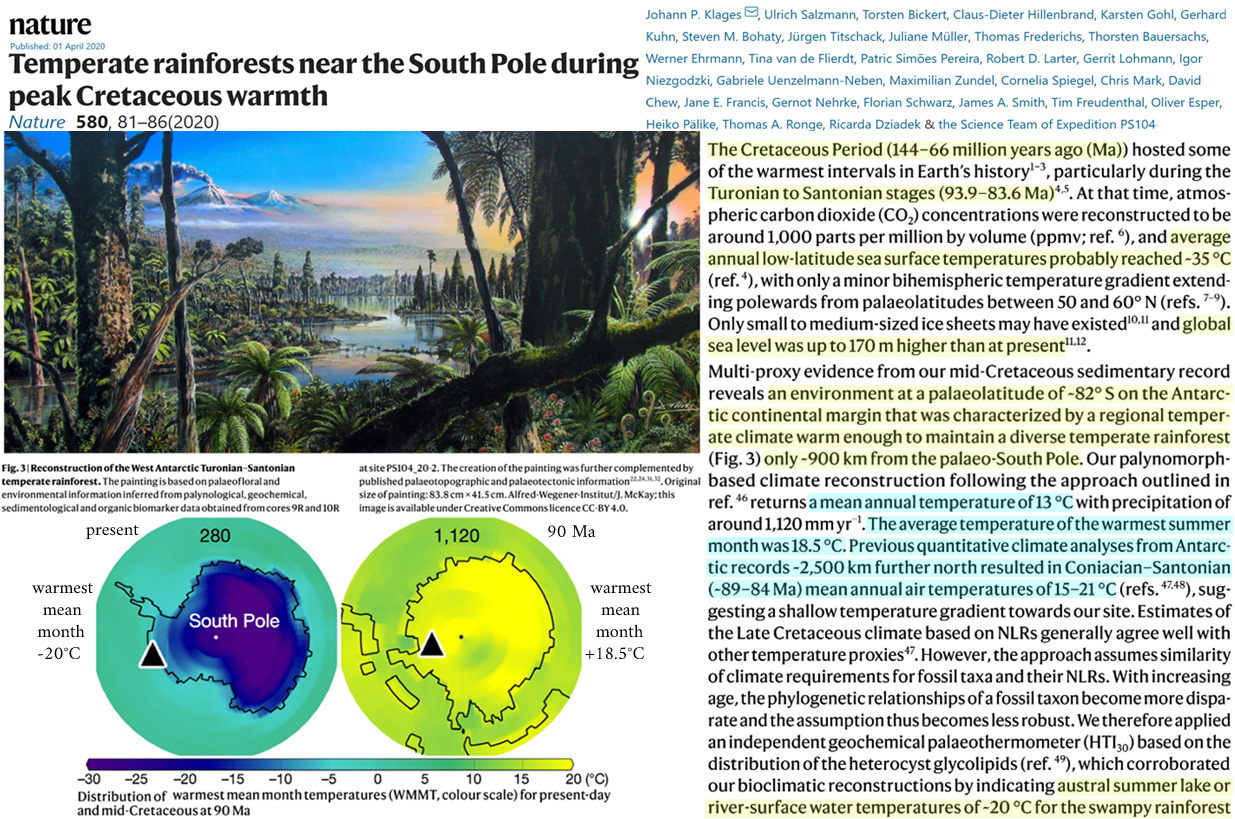Fossilized evidence of temperate rainforests only hundreds of kilometers from Antarctica’s South Pole (82°S) has been uncovered. It suggests the warmest mean month was 18.5°C about 90 million years ago. Today the warmest mean month for this location is about -20°C.

Image Source: EarthSky (press release for Klages et al., 2020)
Despite rapidly rising CO2 concentrations, the Antarctic continent as a whole hasn’t warmed in the last 70 years (Singh and Polvani, 2020).

Image Source: Singh and Polvani, 2020
Scientists have determined that, for Central Antarctica, there is an increasingly negative greenhouse effect as CO2 concentrations rise (Schmithüsen et al., 2015). This means that the more humans emit CO2 by burning fossil fuels, the colder Antarctic temperatures get. The Northern Hemisphere also has a “comparatively weak” near-zero CO2 greenhouse effect for the Arctic (Greenland). These near-zero to negative CO2 greenhouse effect conditions are opposite the (modeled) expectation that rising CO2 amplifies warming in polar climates.

Image Source: Schmithüsen et al., 2015
A fascinating but largely overlooked 2020 Nature study (Klages et al., 2020) reported Antarctica’s dinosaur-age climate was forested and about as warm as southern New Zealand’s today for the region just 500 miles (900 km) from the South Pole (82°S).

Image Source: Klages et al., 2020
The authors indicate low latitude sea surface temperatures “probably reached ~35°C” during the Turonian to Santonian stages roughly 94 to 84 million years ago (Ma), which is 10s of degrees Celsius warmer than present.
For 82°S, the site of this study, mean annual temperatures reached 13°C about 90 Ma. River and lake temperatures reached 20°C in summer and there was “dense vegetation across Antarctica with little or no ice sheet present” (press release). The warmest mean month’s temperature was as high as 18.5°C, which is about 38°C warmer than today’s at this location.
Other climate reconstructions indicate Antarctica’s mean annual temperatures ~2,500 km north of 82°C ranged from 15-21°C from 89-84 Ma. Consequently, with a substantially diminished Antarctic ice sheet, global sea levels are thought to have been about 170 meters higher than today’s during this period.
Oddly, Klages et al. contend CO2 is a driver of Antarctica’s climate in their study. They assert higher CO2 concentrations (i.e., 1,000 ppm) actually lead to substantial warming, not cooling. Apparently these scientists are not aware that rising CO2 concentrations have been determined to elicit a negative greenhouse effect (a cooling influence) for central Antarctica (Schmithüsen et al., 2015).
Or perhaps the fundamental science isn’t settled.





Position of the land mass around the earth? ie. plates move.
What was the sun’s activity at the time? Earth’s tilt & distance to the sun? Atmosphere composition earlier & now? Position & shape of other lands & vegetation that change local & global climates around the globe? Thermal transfer of heat to the poles were different when you had large land masses close together, large unimpeded water flow away from land & higher sea levels.
There’s no such thing as a climate optimum, because “optimum” is a very subjective view. There’s never been a stable climate nor a year of mean temperature/rainfall. The climate is driven by differences & change, it’s full of chaos, never still, never exactly the same. The weather is always moving towards an equilibrium but that’s a moving target & is never achieved. The climate is a set of statistics, abstract not concrete.
Plants, animals & insects etc. are all adapting to their environment without that, they go extinct. Australia like many places had the climate change over many thousands of years as the wet topical-to-temperate gives way to fire/draught/heat tolerant flora & fauna. The natural populations migrate or remain in areas where they can survive or adapt to. They survive the changes in seasons & decadal cycles many adapt & hold on longer than they predict.
I’ve heard something like this before, but there is one thing I don’t understand. No matter how warm it was on Earth, the polar night was always six months. How can plants survive when there is no sunshine for months? Is there something I opversee? Or was the continental drift the reason? Was the Antarctic coninent further north at that time?
Chris Frey
you can go to the north! the plants die in the winter and comes back in the spring! its totaly dark and alot of snow! norway is 71¤ at least.. bring in some more temprature and the plants would thrive much more as in the article!
Has anyone looked into the atmospheric CO2 concentration during the time period discussed in the article?
It’s my contention that a higher atmospheric CO2 concentration lends a higher specific heat capacity to air (as compared to the same parcel of air with a lower CO2 concentration)… more complex polyatomic molecules have more DOF and thus higher specific heat capacity (as compared to the monoatomics and homonuclear diatomics), thus that parcel of air can advect more energy poleward.
Further, since CO2 is a radiative molecule, more CO2 molecules means more energy being convected surface-to-upper-atmosphere, and more molecules capable of emitting radiation, thus more radiation emitted to space, which represents a loss of energy to the system known as Earth… that’s a cooling process.
All of the above may explain why, during the last ice age, archaeological finds in the Arctic showed that people were living above the Arctic circle (something we find difficult to do even today, whereas back then they didn’t have our technology so living there would be even more difficult, assuming today’s Arctic climate), whereas further south there were miles-thick glaciers. We see this theme repeated in trees in the Arctic just recently being disgorged from melting glaciers (which had been growing above the current treeline), and in Viking settlements on Greenland once warm enough to grow crops and raise livestock, whereas today they’ve been under glaciers until just recently.
Nice article, thanks.
Schmithusen et al 2015 is important in showing a negative greenhouse effect over Antarctica. This is a robust finding confirmed by IR spectroscopy by satellites. The CO2 absorption bandwidths, instead of bulging down through absorption, bulge upward with enhancement.
A subsequent 2018 study has confirmed negative “greenhouse” effect over Antarctica but has added an interesting twist: this phenomenon is due to water vapour, not CO2:
https://www.nature.com/articles/s41612-018-0031-y
This is btw a very interesting article in its own right. If the CO2 explanation of the greenhouse effect is deficient over Antarctica, where else may it be deficient and how? Reading between the lines there are hints of disarray in the radiative greenhouse theory and a “traditional” explanation being challenged by a newer “saturation flux” based paradigm. There is more to this than meets the eye.
Notable that Schmithusen et al 2015 and later Sejas et al 2018 show a negative greenhouse effect (GHE) over Antarctica.
https://ptolemy2.wordpress.com/2021/05/16/negative-greenhouse-effect-over-the-high-and-cold-antarctic-plateau/
Interesting comment at the end of Sejas et al., that during ice ages this negative GHE might be more extensive including at the Arctic also.
This would also mean that palaeo-climate explanations of endings of deep “snowball earth” glaciations – like the Cryogenian or Saharan-Andean – caused by rising CO2, will no longer work. More CO2 would make a snowball earth colder, not hotter!
[…] Related: Rainforests Near The South Pole And Summers 38°C Warmer Than Today During The Age Of Dinosaurs […]
[…] Experiences Queen’s relative ‘treated for blood clots following second Covid jab’ Rainforests Near The South Pole And Summers 38°C Warmer Than Today During The Age Of Dinosaurs Rare COVID-19 response in children explained Revealed, how Bill Gates’s influence spreads […]